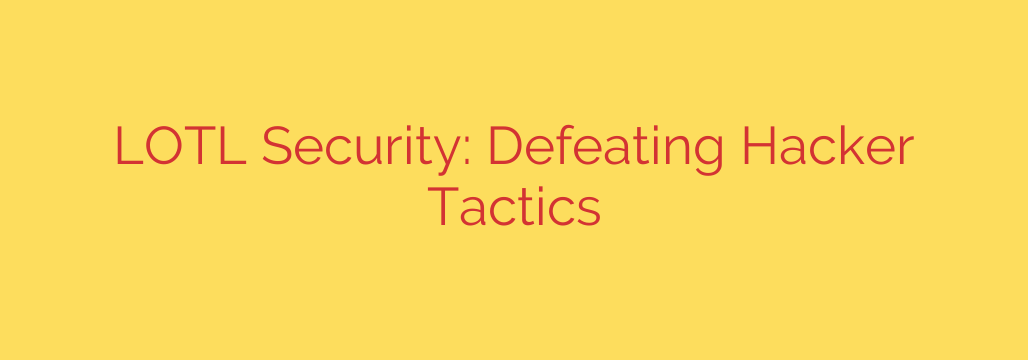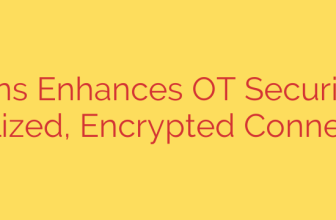
The Silent Threat: A Guide to Detecting and Preventing Living-Off-the-Land (LOTL) Attacks
In the ever-evolving landscape of cybersecurity, attackers are constantly refining their methods to evade detection. One of the most sophisticated and dangerous tactics gaining traction is known as “Living-Off-the-Land” (LOTL). These attacks are notoriously difficult to spot because they don’t rely on traditional malware. Instead, they turn a system’s own legitimate tools and processes against itself, effectively hiding in plain sight.
Understanding and defending against LOTL attacks is no longer optional—it’s a critical component of any modern security strategy. This guide breaks down what these attacks are, why they are so effective, and what you can do to protect your organization.
What Exactly is a Living-Off-the-Land Attack?
Imagine a burglar breaking into a house but, instead of bringing their own crowbar and tools, they use the homeowner’s screwdriver from the garage to disable the locks and the kitchen knives to threaten the occupants. This is the core principle of a LOTL attack.
Cybercriminals gain access to a network and then use pre-installed, legitimate software to carry out their objectives. They leverage native system tools that IT administrators and security software expect to see in a normal environment.
Commonly abused tools include:
- PowerShell: A powerful command-line shell and scripting language used for system administration. In the hands of an attacker, it can be used to run malicious scripts, change security settings, and move laterally across a network.
- Windows Management Instrumentation (WMI): A core component of Windows for managing devices and applications. Attackers use it to execute commands remotely, gather system information, and persist on a network without leaving obvious traces.
- PsExec: A legitimate Sysinternals tool that allows administrators to execute processes on other systems. It is frequently exploited by attackers for lateral movement.
- Certutil: A command-line program installed in Windows to manage certificates, but it can also be abused to download malicious payloads from the internet, masquerading as a benign system activity.
The primary danger of LOTL attacks is that they blend in with legitimate administrative traffic, making them nearly invisible to security solutions that are only looking for known malicious files or signatures.
Why Traditional Security Measures Often Fail
Many legacy security systems, like traditional antivirus software, are built on a foundation of signature-based detection. They maintain a vast database of known malware files and scan your system for matches. If a file’s digital signature matches one in the database, it’s flagged and quarantined.
LOTL attacks completely bypass this model.
Since these tactics use trusted, often Microsoft-signed executables, they don’t trigger alerts. There is no “malicious file” to detect. Instead, the malicious activity is hidden within the behavior of legitimate processes. Your security tools see PowerShell running, which is normal, and fail to recognize it’s being used to exfiltrate sensitive data.
Actionable Strategies to Defend Against LOTL Attacks
Defeating a threat that hides in plain sight requires a shift in mindset—from preventing bad files to detecting bad behavior. A robust defense is built on layers of visibility, control, and proactive monitoring.
Here are five critical steps you can take to fortify your defenses.
1. Implement the Principle of Least Privilege (PoLP)
One of the most effective ways to limit the damage of any attack is to restrict user and application permissions. If an attacker compromises a standard user account, they shouldn’t have the administrative rights needed to run powerful tools like PowerShell or WMI. Enforce PoLP strictly, ensuring that accounts only have the minimum level of access required to perform their duties. This significantly reduces the attacker’s ability to move laterally and escalate their privileges.
2. Leverage Application Control and Whitelisting
Instead of trying to block a list of “bad” applications, application control focuses on defining a list of “good,” approved applications that are allowed to run. By creating a policy that only permits essential programs to execute, you can prevent attackers from using unauthorized—or even authorized but non-essential—tools to advance their attack. This is a powerful way to block the unauthorized execution of scripting tools like PowerShell in environments where they are not needed.
3. Enhance Your Logging and Monitoring Capabilities
If you can’t see it, you can’t stop it. Comprehensive logging is your best tool for uncovering LOTL activity. You must collect and analyze detailed logs that provide insight into system behavior. Key areas to focus on include:
- Command-line process auditing: Log the full command lines for all processes created. This shows you exactly what commands were run, not just that “powershell.exe” was executed.
- PowerShell script block logging: This records the actual content of scripts run through PowerShell, revealing the attacker’s commands.
- Network traffic analysis: Monitor for unusual outbound connections, especially from system processes that normally wouldn’t communicate with external servers.
Having visibility into endpoint activity is non-negotiable for detecting these stealthy tactics.
4. Deploy an Endpoint Detection and Response (EDR) Solution
EDR solutions are specifically designed to combat advanced threats like LOTL. Unlike traditional antivirus, EDR focuses on behavioral analysis. It continuously monitors endpoint activity—process creation, registry modifications, network connections—and uses machine learning and threat intelligence to identify suspicious patterns. An EDR tool can distinguish between a system administrator using PowerShell for a legitimate task and an attacker using it to download ransomware.
5. Harden Your System Tools
Finally, take steps to secure the very tools that attackers love to abuse. For PowerShell, this includes enabling Constrained Language Mode, which limits its capabilities to basic tasks and prevents access to sensitive system functions. Combined with robust logging and user restrictions, this makes one of the attacker’s favorite tools significantly less useful for malicious purposes.
Staying Ahead of the Stealthy Threat
Living-Off-the-Land attacks represent a fundamental shift in the cyber threat landscape. They prove that a determined attacker doesn’t need sophisticated malware to cause significant damage. By understanding their methods and adopting a security posture focused on behavioral monitoring, least privilege, and proactive defense, you can effectively unmask these hidden threats and protect your organization from even the most subtle attacks.
Source: https://www.helpnetsecurity.com/2025/10/01/bitdefender-gravityzone-platform-phasr/








